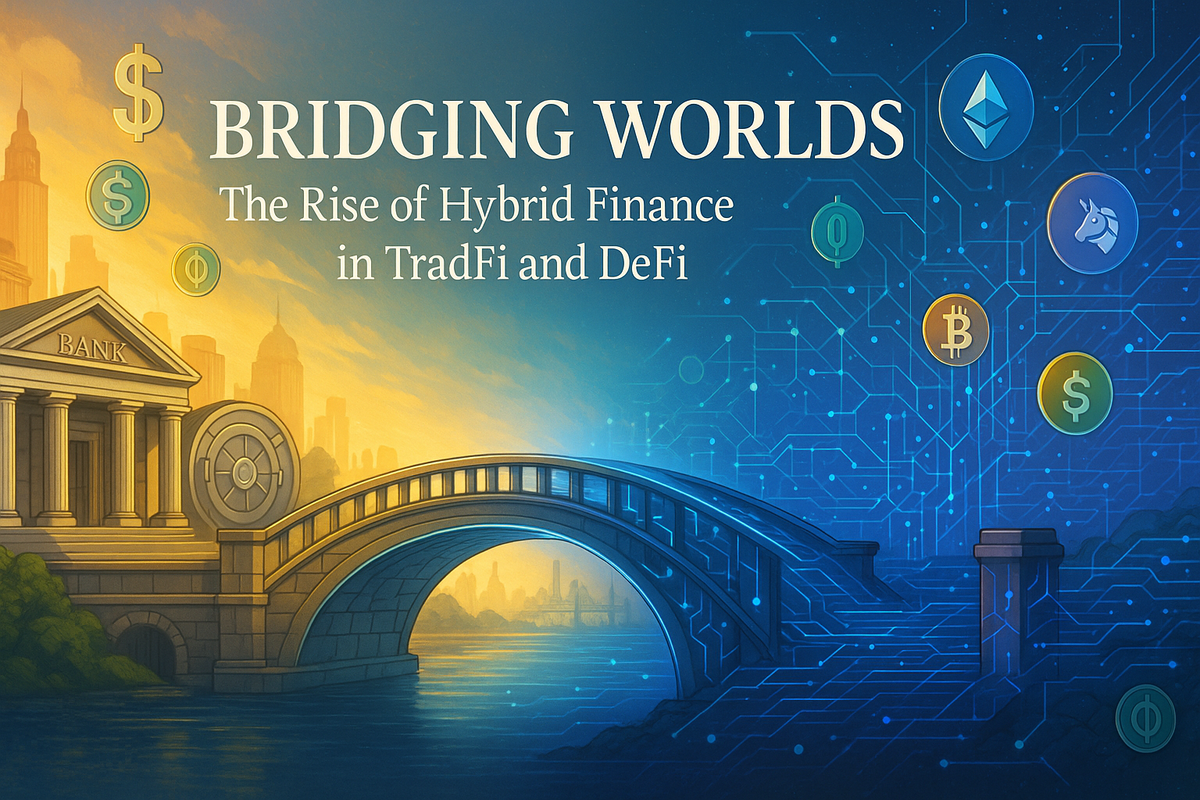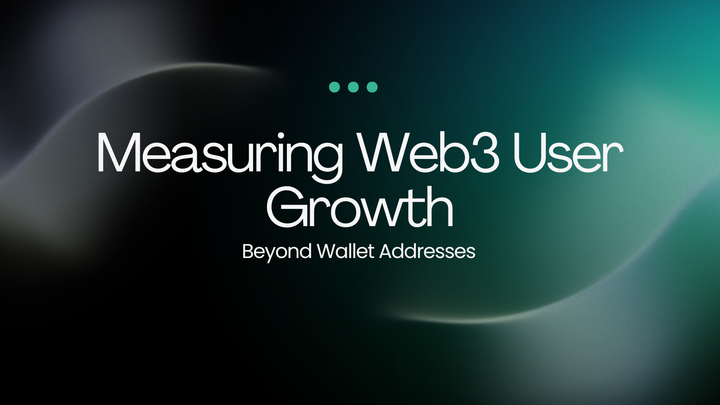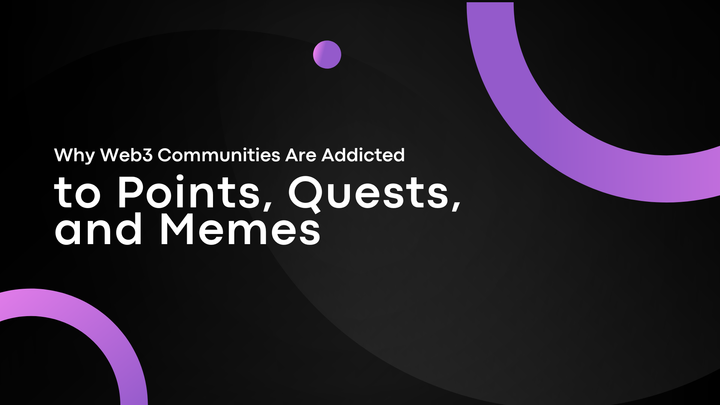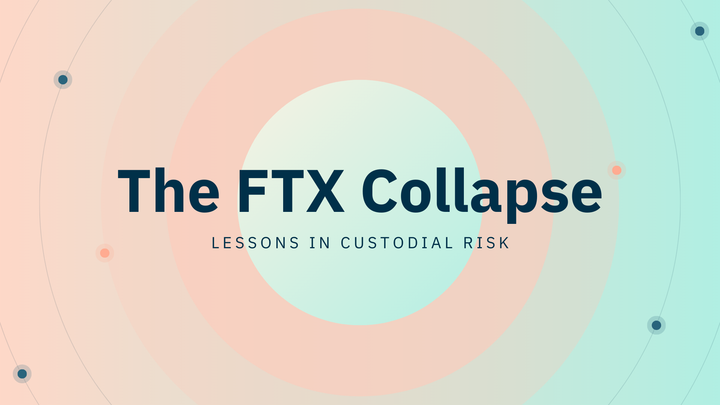Bridging Worlds: The Rise of Hybrid Finance in TradFi and DeFi

Abstract
The world of finance is changing as Traditional Finance (TradFi) and Decentralized Finance (DeFi) start to come together, creating what is often called "Hybrid Finance" (HyFi). This article looks at how both systems have developed over time, what they stand for, and how they work. It points out the strengths and weaknesses of each, as well as what they have in common. By comparing the two, it shows how a combined model could offer the best of both worlds—TradFi’s stability and rules, along with DeFi’s speed, openness, and access for more people. With new ways of blending the two, like tokenization, centralized exchanges, and hybrid credit models, this mix could make global finance more fair, efficient, and strong, helped by new technology and changing rules.
Introduction: The Evolution of Finance
The global financial system is at an important turning point, influenced by the growth of both Traditional Finance (TradFi) and Decentralized Finance (DeFi). TradFi, which has been around for hundreds of years, offers stability, protects consumers, and follows government rules. On the other hand, DeFi uses blockchain technology to give people easier access to financial services, with more openness and faster innovation (Paystand). Even though they work in different ways—one being centralized and the other decentralized—both systems provide key services like lending, borrowing, trading, and managing assets. This article looks at how TradFi and DeFi work, what they stand for, and how they compare. It also supports the idea of combining the two, using the strengths of each to build a financial system that is more fair, efficient, and strong (Aspect Advisory).
Traditional Finance (TradFi): Basics and History
What is Traditional Finance?
Traditional Finance, or TradFi, is the regular financial system that’s been around for centuries. It uses centralized groups like banks, insurance companies, and stock exchanges to handle money and services. Governments regulate these to protect people, like with deposit insurance or fraud prevention, which keeps things stable (Ledger). TradFi’s systems, built over years, include payment networks, loans, and investments, all using regular money like dollars or euros (Liminal Custody).
History of TradFi
TradFi started in ancient Mesopotamia around 2000 BCE with grain banks and bartering for loans. Metal coins came around 500 BCE, and paper money appeared in China in the 10th century. In 1799, Adam Smith’s “invisible hand” idea pushed for less government control in banking (First Utah Bank). Central banks, like the First Bank of the United States in 1791 and the Federal Reserve in 1913, helped stabilize money and banking (Relay). The Great Depression in 1929 led to new rules, including the Federal Deposit Insurance Corporation (FDIC) to build trust (Relay). After World War II, things like ATMs (1967) and online banking made finance global (Relay).
Key Features of TradFi
TradFi follows rules for accountability, fairness, and managing risks, ensuring good governance (Liminal Custody). Its main features are:
- Centralized Control: Banks and others manage transactions (Ledger).
- Lots of Rules: Regulations protect people and keep markets steady (Liminal Custody).
- Strong Systems: Years of building make it reliable (Ledger).
- Regular Money: Uses dollars, euros, and other government currencies (Liminal Custody).
- Expert Help: Offers professional advice and tools to manage risks (Ledger).
- Widely Used: Works with governments for economic planning (Liminal Custody).
But TradFi’s centralized setup means higher costs, slower transactions, and less access for people without bank accounts. Account freezes or extra paperwork can also limit control (Paystand).
Who’s Involved and What They Do
TradFi includes banks, insurance companies, stock exchanges, real estate funds, asset managers, and brokers. They serve workers, investors, and governments. Services include savings accounts, loans (like mortgages), currency exchange, investment funds, insurance, and wealth management, helping industries like real estate and insurance (Liminal Custody).
Decentralized Finance (DeFi): Basics and Growth
What is Decentralized Finance?
DeFi is a system built on blockchain that skips middlemen like banks. It uses smart contracts—automatic, coded agreements—on platforms like Ethereum to handle financial services (Paystand). These contracts make transactions trustless, relying on code instead of institutions, but the code can have bugs, so it needs careful checking (TRM Labs).
How DeFi Grew
DeFi started with Bitcoin in 2009, showing money could move without banks. Ethereum’s 2015 launch brought smart contracts, leading to apps and early DeFi platforms like decentralized exchanges (DEXs) from 2016–2018. In 2020, the “DeFi Boom” took off, with Total Value Locked (TVL) hitting over $100 billion by 2021. Low returns in regular markets, NFT popularity, and DeFi’s open-source setup drove this growth(Binance).
Key Features of DeFi
DeFi focuses on being open, transparent, and flexible, with no central control. Its main features are:
- Open to All: Anyone with internet can use it, no credit checks needed.
- Clear and Safe: Blockchain records are public and hard to change.
- Low Costs: Smart contracts make transactions cheaper and faster.
- Flexible Building: Open-source code lets developers create new tools fast.
- Always On: Works 24/7, no business hours.
- User Control: People keep their money in personal wallets, not with banks.
But DeFi has risks:
- Code Problems: Bugs in smart contracts can cause big losses.
- No Clear Rules: Lack of regulation raises concerns about safety and legal help.
- Price Swings: Crypto prices can change fast, risking money.
- KYC/AML Issues: Anonymous transactions make it hard to follow anti-crime rules.
- Hard to Use: Complex apps and wallets scare off new users.
Main DeFi Services
DeFi offers services like TradFi but in new ways:
- Decentralized Exchanges (DEXs): Platforms like Uniswap, SushiSwap, and PancakeSwap let people trade directly with smart contracts, offering many trading options.
- Lending and Borrowing: Aave and Compound let users earn interest or borrow with collateral, no banks needed.
- Stablecoins: USDT, USDC, and DAI keep steady values for trading and earning in shaky markets.
- Yield Farming: Users earn rewards by adding money to liquidity pools.
- Synthetic Assets: These mimic real-world assets for trading without owning them.
- Governance Tokens: Tokens like UNI and AAVE let users vote on changes, giving them control and encouraging community ideas.
Comparing TradFi and DeFi
Main Differences
TradFi and DeFi work differently, affecting how they operate:
- Control: TradFi uses banks; DeFi uses smart contracts for direct deals.
- Rules: TradFi has lots of regulations for stability; DeFi’s lack of rules boosts innovation but risks chaos.
- Middlemen: TradFi needs banks or brokers; DeFi skips them with automation.
- Access: TradFi limits people without credit or in certain areas; DeFi is open to anyone with internet.
- Speed and Cost: TradFi is slow and costly (days for transfers); DeFi is fast and cheap.
- Innovation: TradFi’s rules slow changes; DeFi’s open code speeds them up.
- Transparency: TradFi keeps data private; DeFi’s blockchain is open to all.
- Money Control: TradFi banks hold funds, risking freezes or paperwork; DeFi gives users full control with wallets.
- Global Transfers: TradFi has limits and costs; DeFi is global and cheap.
- Lending/Borrowing: TradFi needs lots of documents; DeFi uses collateral (150–200% of loan), which can be tough for some.
- Insurance: TradFi has FDIC to cover losses; DeFi uses smart contracts for specific risks.
- Trust: TradFi trusts banks and laws; DeFi trusts code and rewards.
These show different ways to manage risks, with TradFi using rules and DeFi using code.
Table: TradFi vs. DeFi Differences
Aspect | Traditional Finance (TradFi) | Decentralized Finance (DeFi) |
|---|---|---|
Control | Banks and regulators control it | Smart contracts and blockchain, no central control |
Rules | Lots of rules for safety and stability | Few rules, encourages innovation but risky |
Middlemen | Needs banks or brokers | No middlemen, uses smart contracts |
Access | Limited by location or credit | Open to anyone with internet |
Speed/Cost | Slow, high fees (days for transfers) | Fast, low fees (near-instant) |
Transparency | Private databases, not open | Public blockchain, anyone can see |
Money Control | Banks hold it, can freeze accounts | Users control it with wallets |
Global Transfers | Limited, costly | Global, fast, cheap |
Lending/Borrowing | Needs documents, credit checks | Uses collateral, no documents, high collateral needed |
Insurance | FDIC covers some losses | Smart contracts cover specific risks |
Trust | Trusts banks and laws | Trusts code and rewards |
Table 1: Comparing TradFi and DeFi features.
Shared Goals
Even with differences, TradFi and DeFi want similar things: moving money efficiently, creating wealth, managing risks, and keeping transfers safe. TradFi uses rules and reserves, while DeFi uses extra collateral and data feeds called oracles (Binance). Both need liquidity, but TradFi keeps it separate, while DeFi uses flexible pools (Paystand).
Table: Financial Tools Compared
Category | Traditional Finance (TradFi) | Decentralized Finance (DeFi) |
|---|---|---|
Main Asset | Regular money (USD, EUR) | Crypto tokens (ETH, SOL, BTC) |
Safe Returns | Government bonds (e.g., U.S. Treasuries) | Staked ETH, tokens like stETH |
Loans | Corporate bonds, bank loans | DeFi protocol debt (e.g., aUSDC, cDAI) |
Investment Types | Stocks, mutual funds | Protocol tokens (e.g., UNI, AAVE), LP tokens |
Table 2: Comparing financial tools in TradFi and DeFi.
New Ways TradFi and DeFi Work Together
TradFi and DeFi are starting to mix, creating Hybrid Finance (HyFi) with benefits for both:
- FinTech Apps: Apps like CashApp and Robinhood let people trade crypto in a regulated way, making DeFi assets easy to use (Aspect Advisory).
- Digital Currencies from Banks: Central banks are testing digital money (CBDCs) using blockchain, mixing DeFi’s tech with TradFi’s rules (Aspect Advisory).
- Regulated Crypto Exchanges: Binance and Coinbase offer DeFi tools with rules like KYC/AML, making it easier to join DeFi (Aspect Advisory).
- Tokenized Assets: Turning things like property or art into digital tokens makes them easier to trade, drawing TradFi investors to DeFi (Aspect Advisory).
- Private Credit Models: TradFi funds safer loan parts, while DeFi funds riskier ones, balancing stability and flexibility to meet funding needs (Aspect Advisory).
Other Challenges to Mixing TradFi and DeFi
Besides rules and security, there are more hurdles:
- Scalability: Ethereum can’t handle as many transactions as TradFi, even with tools like Optimism and Arbitrum.
- User Adoption: DeFi’s tricky apps and wallets make it hard for regular people to use, needing simpler designs and education.
- Environment: Bitcoin’s high energy use gets criticism, but DeFi’s switch to Proof of Stake, like Ethereum’s 2022 Merge, fits TradFi’s green goals (Cointelegraph).
Social and Economic Effects
Mixing TradFi and DeFi has big impacts:
- Stronger Economy: Hybrid models spread out money sources, reducing risks like those in the 2008 crisis.
- New Jobs: Blockchain and DeFi create jobs in coding, compliance, and auditing, boosting skills in both fields (Cointelegraph).
What’s Next: The Future of Hybrid Finance
By 2030, digital currencies from banks and tokenized asset markets could make DeFi a normal part of TradFi. Digital identity tools could solve KYC/AML issues, fitting DeFi with rules. HyFi could change real estate with shared ownership or make supply chain finance clearer, creating a fully connected financial future (Cointelegraph).
Conclusion: A Better Financial System
TradFi and DeFi aren’t replacing each other—they’re blending strengths. TradFi brings stability, rules, and lots of money, while DeFi offers speed, openness, and access for all. To make Hybrid Finance real, people need to act:
- Regulators should make clear rules, like the EU’s MiCA, to balance innovation and safety.
- Developers should build easy-to-use DeFi apps and strong security to gain trust.
- Institutions should team up with DeFi to create new tools like tokenized assets and loans.
By fixing rules, improving security, connecting tech, and working together, the financial world can open up to more people, speed up transactions, and stay strong, changing finance for the better (Cointelegraph).
References
- Aspect Advisory, https://www.aspectadvisory.eu/tradfi-and-defi/
- Binance, https://www.binance.com/en/square/post/171701
- Cointelegraph, https://cointelegraph.com/news/trad-fi-will-keep-its-distance
- First Utah Bank, https://firstutahbank.com/the-history-of-banking-from-ancient-times-to-now
- Ledger, https://www.ledger.com/academy/glossary/tradfi
- Liminal Custody, https://www.liminalcustody.com/glossary/tradfi
- Paystand, https://www.paystand.com/decentralized-finance-defi-the-future-of-finance
- Relay, https://relay.fi/blog/evolution-of-banking
- Tiger Brokers, https://www.tiger.com/news/2535775344
- TRM Labs, https://www.trmlabs.com/glossary/decentralized-finance
Similar Articles
The Ethics of Immutability: "Code is Law" and Its Consequences
🔒 Smart Contracts: Redefining Trust Through Code
From Anarchy to Autonomy: Reimagining Society Through Blockchain and Web3
Navigating GDPR and Public Blockchain: Challenges and Solutions
Privacy vs. Transparency: Balancing Blockchain’s Open Ledgers with Personal Rights
Tokenization of Real World Assets (RWA): How Blockchain Is Opening the Doors to Traditional Finance
The Tokenization of Everything: A New Paradigm for Value, Ownership, and Access
Blockchain as a Catalyst for Societal Change: Utopian Visions vs. Dystopian Realities



Comments ()